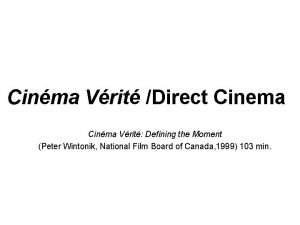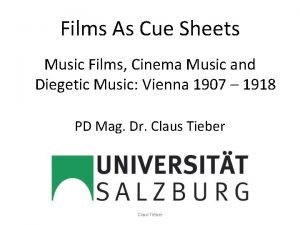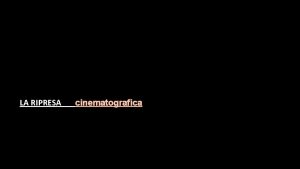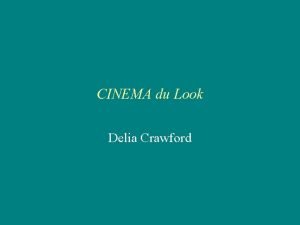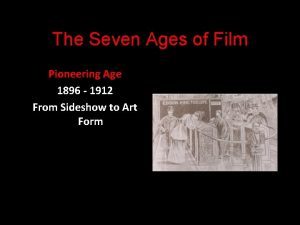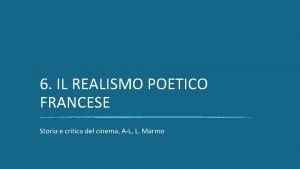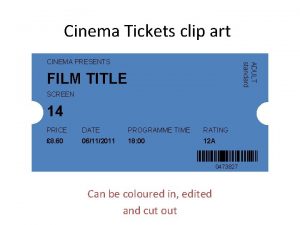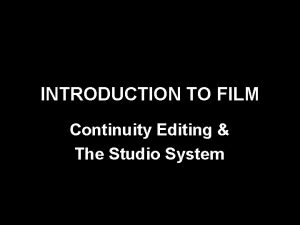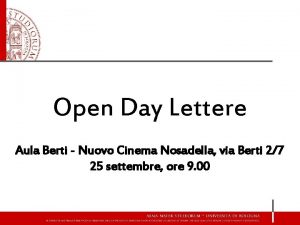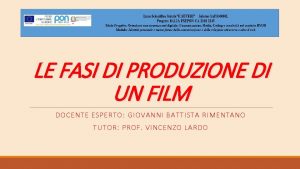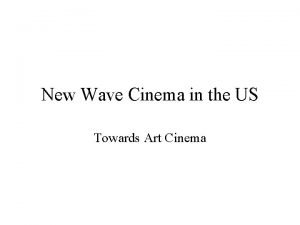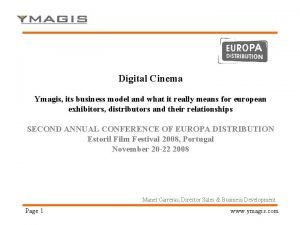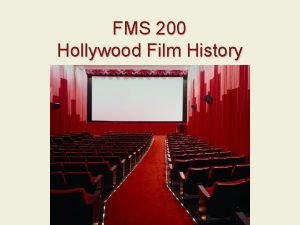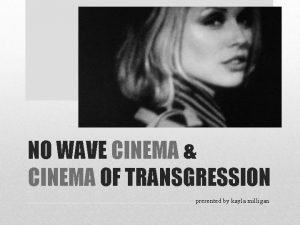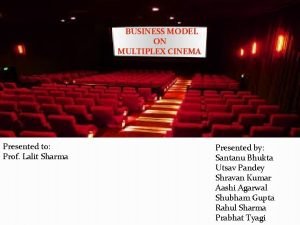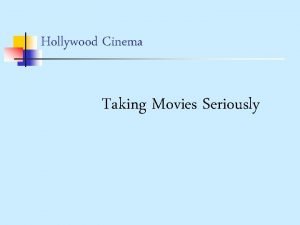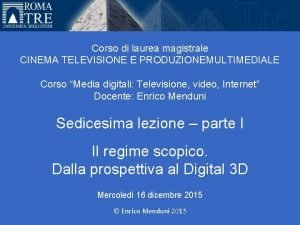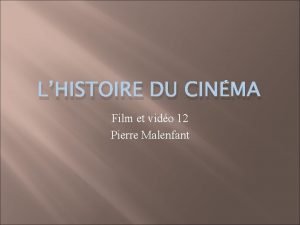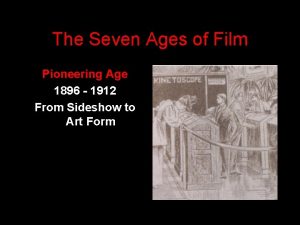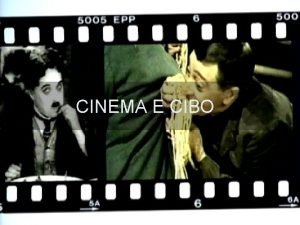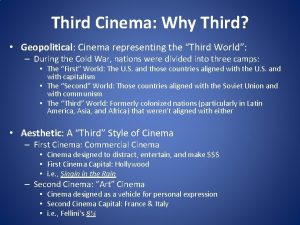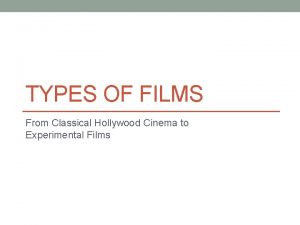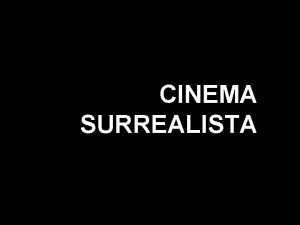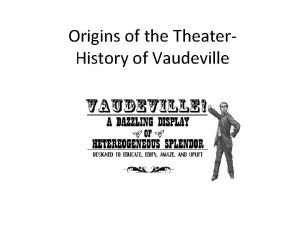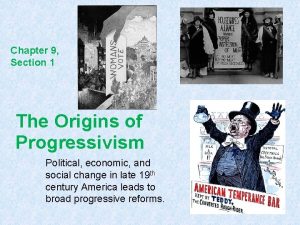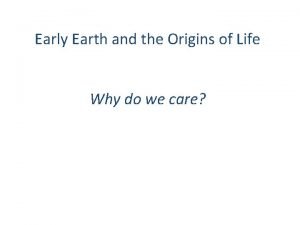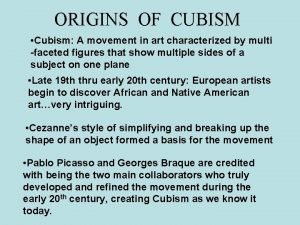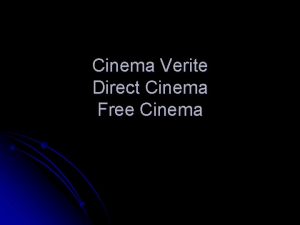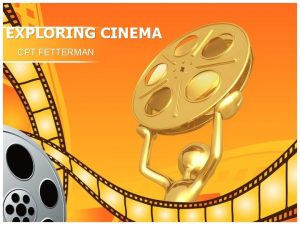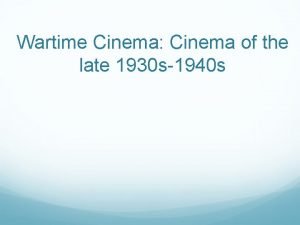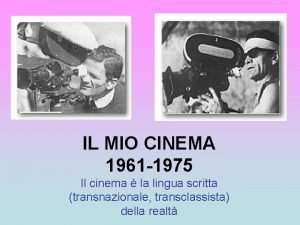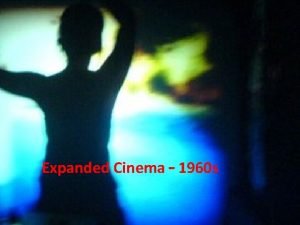THE HISTORY OF CINEMA At the Origins of












































































- Slides: 76

THE HISTORY OF CINEMA At the Origins of Movie Industry (Western world)

The Seven Ages of Film Pioneering Age 1896 - 1912 From Sideshow to Art Form

The Seven Ages of Film The Silent Age 1913 - 1927 The emergence of Hollywood World War I and the exodus from Europe

The Seven Ages of Film The Transition Age 1928 -32 From Silent to Sound

The Seven Ages of Film The Hollywood Studio Age 1932 - 1946 Domination by the Studio Genre movies World War II

The Seven Ages of Film The Internationalist Age 1947 - 1959 Hollywood Studio decline The challenge of TV

The Seven Ages of Film The New Wave Age 1960 - 1980 From France to the world Technological innovation Small scale productions Strong social / political value to film.

The Seven Ages of Film The Mass Media Age 1980 - present Film & movies as part of the global entertainment / communications media Digital production

The Seven Ages of Film Pioneering Age 1896 - 1912 From Sideshow to Art Form

History Mechanisms for producing moving images had been demonstrated from the 1860 s. – ZOETROPES (a. k. a. PRAXIONOSCOPES AND KINEOSCOPES)

ZOETROPE A zoetrope is one of several precinema animation devices that produce the illusion of motion by displaying a sequence of drawings or photographs showing progressive phases of that motion. The name zoetrope was composed from the Greek root words ζωή zoe, "life" and τρόπος tropos, "turning".

History ZOETROPES relied on the “persistence of vision” to provide an illusion of movement if the images were moved at sufficient speed past the viewer.

Edward Muybridge In 1904 Edward Muybridge, an Englishman, needed to settle a $25, 000. 00 bet. He believed that a galloping horse had all four feet off of the ground at the same time but others said that this was impossible. The problem was that galloping hooves move too fast for the eye to see.

More than just a bet To settle the bet indisputable proof was needed. In an effort to settle the issue once and for all an experiment was set up in which a rapid sequence of photos was taken of a running horse. When the pictures were developed it was found that the horse did indeed have all four feet off the ground for a split-second.

Discovery! Why is this significant? In doing this experiment they found out something else — something that becomes obvious from the illustrations of the horse on the left.

The Illusion of Continuous Movement When a series of still images of a moving object are viewed at a certain speed the illusion of motion is created. In the case of Muybridge’s series of still photos, when they were presented sequentially at 0. 1 second intervals they created the illusion of continuous motion. This is Muybridge’s actual footage

The Phi Phenomenon explains why, when your view a series of slightly different still photos or images in rapid succession, an illusion This is Muybridge’s actual footage of movement is created in the transition between the images.

Persistence of Vision This is Muybridge’s actual footage Persistence of Vision is the phenomenon that explains why the intervals between the successive images merge into a single image as our eyes hold one image long enough for the next one to take its place.

The First Photograph In 1822, Frenchman Joseph Nicepce was the first to produce a basic photographic image. The earliest known photograph - 1822 But, in 1839 Louis Daguerre patented a process that could actually be considered photography. His photos were referred to as daguerreotypes.

Daguerrotypes There were obvious problems with this process. The only way to capture images was to make metal plates light-sensitive by painting them with a liquid solution while you were in a darkroom. You would need to expose them in a camera before they dried and then return to the darkroom to develop them. An 1837 Daguerreotype photograph

Celluloid An inventor by the name of Hannibal Goodwin greatly simplified the process in 1889, when he developed a transparent, pliable film base called celluloid. The next step was to create long strips of film where a series of still pictures could be captured in rapid succession. Film now comes in lengths up to 1000’

Almost a Great Idea Thomas Edison’s Kinetograph Soon, a host of devices were invented to entertain anyone who wanted (for a price) to watch "moving images. " Unfortunately, all of these devices had the disadvantage of only having an audience of one. A viewer would look through a peephole at a series of drawings or photos presented in rapid sequence.

History The development of the motion picture projector and film stock allowed the development of film. Early motion pictures were static shots showing an event or action with no editing or other cinematic techniques as this series showing a nude walking demonstrates.

History � � Early films were a visual art until the late 19 th century when they developed into a narrative with a series of scenes linked together to tell a story. Scenes were broken up into multiple shots of varying sizes and angles. Camera movement was used to add to the story development. Music was used to create mood using a pianist / organist using either sheet music or a score as they accompanied the screen action.

Film History » The first audience to experience a moving film did so in 1895. The film, by the Lumiere brothers was called “Workers leaving the Lumiere Factory (1895)” » Their film “Train Entering the Gare de Ciotat (1895)” caused people to faint with fear as the train loomed from the screen into theatre auditorium. » These films did not carry a story or narrative - they merely showed a moving image on the screen.

“LES LUMIERES” A colourised still of the Train Entering the Gare de Ciotat Station. Playing petanque (1895) » August (1862 -1954) & Louis (1864 -1948) Lumiere

The Lumière brothers were born in Besançon, France and moved to Lyon in 1870, where both attended La Martiniere, the largest technical school in Lyon. Their father, Claude. Antoine Lumière (1840– 1911), ran a photographic firm where both brothers worked for him: Louis as a physicist and Auguste as a manager. Louis had made some improvements to the still-photograph process, the most notable being the dry-plate process, which was a major step towards moving images. Cinématographe Lumière at the Institut Lumière, France It was not until their father retired in 1892 that the brothers began to create moving pictures.

They patented a number of significant processes leading up to their film camera, most notably film perforations) as a means of advancing the film through the camera and projector.

The brothers stated that "the cinema is an invention without any future" and declined to sell their camera to other filmmakers such as Georges Méliès. This made many film makers upset. Consequently, their role in the history of film was exceedingly brief. They turned their attentions to colour photography and in 1903 they patented a colour photography process, the "Autochrome Lumière", launched on the market in 1907. Throughout much of the 20 th century, the Lumière company was a major producer of photographic products in Europe, but the brand name, Lumière, disappeared from the marketplace following merger with Ilford.

Simple Films The Lumiere film café circa 1895 While the Lumière films were “actualities” shot outdoors on location, Edison’s films featured circus or vaudeville acts that were shot in a small studio before a stationary camera. In both cases the films were composed of a single unedited shot with little or no narrative content.

Film History - Georges Méliès » Realising the potential of a good story George Melies ( 1861 -1938) utilised film to create fantastic stories that took his characters and audiences to the moon and beyond.

The changing process of cinema » The changes in film process involve several factors. George Huaco indentifies four factors: 1. Current events & achievements. (political climate) 2. The creativity of the filmmakers who influenced the team of crafts-people involved in the films. 3. The technical developments that could be exploited. 4. The capacity of a sufficient audience to appreciate the results.

The Seven Ages of Film The Silent Age 1913 - 1927 The emergence of Hollywood World War I and the exodus from Europe

Changing process of cinema » “The division between film and movie creates two views of quality and purpose” MOVIES = This is a commercial differentiation = popular entertainment with a mass circulation of copies of the movie. The audience being largely passive.

Changing process of cinema » “The division between film and movie creates two views of quality and purpose” MOVIES = This is a commercial differentiation = popular entertainment with a mass circulation of copies of the movie. The audience being largely passive. » . The product of an industry dominated by the producer (money) in which there is no individual film-maker but a team under the producer’s control. (The studio system. ) The director is hired to create the movie from the script. The final version is, however, the responsibility of the Producer and Editor.

Changing process of cinema » “The division between film and movie creates two views of quality and purpose” MOVIES = This is a commercial differentiation = popular entertainment with a mass circulation of copies of the movie. The audience being largely passive. » . The product of an industry dominated by the producer (money) in which there is no individual film-maker but a team under the producer’s control. (The studio system. ) The director is hired to create the movie from the script. The final version is, however, the responsibility of the Producer and Editor. » The director of a movie is known as: metteur en scene = an interpreter of a score / script.

Progressions - The Silent Film » Film makers experimented with the use of the camera to develop new techniques that would enhance their ability to tell a story. » 1913: Giovanni Pastrone (Cabiria) moved his camera laterally and slightly above the level of the forreground thus changing the perspective of the audience from that they’d previously had in the Luniere films. » 1923: Carl Mayer directing Last Laugh for F. W. Murnau proposed a forward movement of the camera at dramatic moments as if to thrust the audience into the action.

LAST LAUGH The Last Laugh/ Der Letzte Mann was a 1924 B&W silent film about the changing fortunes of a hotel doorman. Directed by F. W. Murnau and written by Carl Mayer it is noteworthy for its use of a moving camera (one of the first to do so) and near lack of intertitles. Murnau’s most famous movie was , however, NOSFERATU and adaptation of Bram Storker’s Dracula.

Progressions - The Silent Film » F. W. Marnau influenced the film making process with the introduction of the design tool - the STORYBOARD. This is a script visualised by drawings of every basic change of camera angles in the film. » Marnau was influenced by the swing to the right in Germany post W/W I where business took advantage of the high inflation rate to mass produce films at cheap rates.

Progressions - The Silent Film » The storyboard design focus introduced techniques like VISUAL PUNNING” that (e. g) involved showing the passage of time by tracking towards a candle flame then dissolving into a lighted gas jet or electric bulb from which they would track away to the next sequence of the story. » This technique was replaced by nouvelle vague that introduced jump cuts to show or allow the passage of time and space. » This was known as “kultur-film” in Germany. » World War I signaled the advance of the movie from the USA. This was because while Europe was fighting a four year long war, costing 10 million dead, the Americans only fought for six months at a cost of 115, 000 dead. The 10 years of prosperity in the USA allowed the industry to gain dominance.

IN THE MEANTIME IN THE US…. .

Edison and Eastman THOMAS EDISON had developed projectors that could do this at a rate of 16 frames per-second. (The rate was later moved up to 18 frames, and eventually to 24 FPS. ) A few years later, GEORGE EASTMAN standardized film widths for cameras and projectors to 16 and 35 mm. George Eastman and Thomas Edison

Edison’s Kinetoscope (how to develop other people’s invention) Kinetoscope Parlor in 1899 Howevr, the Edison profits came from the sale of machines and prints, not from exhibition to the general public. . From the Edison viewpoint, one machine for every viewer was more to be desired than a hundred or more viewers for every machine. LATER HE REALIZED THE MISTAKE….

Vaudeville and The Movies! A vaudeville theater in the early 1900’s During this time, VAUDEVILLE (small theaters that featured short dramatic skits, comedy routines, and song and dance numbers) was quite popular. In order get one-up on the competition and fill in time between acts, vaudeville theaters started featuring short films.

Nickelodeons As the 1900 s dawned, vaudeville expanded into NICKELODEONS, which were small storefront-type theaters that featured films (accompanied by piano music and sound effects) along with one or two vaudeville acts. As the name suggests, admission was only a nickel. A vaudeville theater in the early 1900’s

A Booming Industry in Changng Times As films got more popular and longer, the vaudeville acts disappeared from the nickelodeons and the MOTION PICTURE THEATER was born - if you can call a small room with wooden benches a motion picture theater. As their popularity grew, films had to be changed often. A nickelodeon in the early 1900’s

An Early Epic: The Great Train Robbery Pioneers of Film Editing In 1903, Edwin S. Porter, an employee of Thomas Edison, shot the first narrative film, The Great Train Robbery. The film featured a dramatic story line and cross cutting between different locations and camera angles. It had 14 scenes and lasted 12 minutes, making it an epic of its day.

The Great Train Robbery (1903) � � � First Western First to use editing as a storytelling technique One of the first to use panning and close-ups Moved from documentary to narrative Based on a true robbery by Butch Cassidy

Panning and close-ups PANNING refers to the rotation in a horizontal plane of a still camera or video camera. Panning a camera results in a motion similar to that of someone shaking their head from side to side. CLOSE_UP is a type of shot, which tightly frames a person or an object. Close-ups are one of the standard shots used regularly with medium shots and long shots

Progressions - The Silent Film The man who exploited this change was D. W. Griffith (18751948. USA) whose film “The Birth of a Nation (1914) created an explosive examination of the development of the American nation from the Civil War. The films until then were narrative and anecdotal this followed several threads of narrative - the friendly families in the North & South, political events in Washington, warfare with friends in opposite camps, exploitation of the South, white & black, carpet baggers from the North and the rise of the Ku Klux Klan.

Birth of a Nation (1915) � � Based Thomas Dixon Jr. 's antiblack, bigoted play, The Clansman Its release set up a major censorship battle over its vicious, extremist depiction of African Americans. Unbelievably, the film is still used today as a recruitment piece for Klan membership. 3 Hours long (longest film to date) Black characters in leading roles are played by white actors in blackface

Birth of a Nation (1915) � � � It was one of the biggest box-office money-makers in the history of film, due to its charge of $2 per ticket. It made $18 million by the start of the talkies. The subject matter of the film caused immediate criticism and renounced as "the meanest vilification of the Negro race. " Riots in Boston and Philadelphia. Chicago, Denver, St. Louis and other major cities refuse to show it

Progressions - The Silent Film Griffith’s success was also his undoing. His films - Intolerance The Mother & The Law and The Fall of Babylon put him into debt. As a result Financiers ceased to regard the film-makers as the king-pins of production and decided to build up the film-star in their place - to put control in the hands of the producer, aided by his team of organizers and writers. (The Hollywood system). This favored the MOVIE over the film and reduced the risk for the banks. . But they also introduced the language (french = way of speaking) of the film- long shot / mid shot/ close-up and their variations. These terms allowed the editor to construct a movie or film to produce identified reactions from the audience.

STARS OF THE SILENT SCREEN

FLORENCE LAWRENCE America’s 1 st Movie Star

CHARLIE CHAPLIN

HAROLD LLOYD

BUSTER KEATON

The Seven Ages of Film The Transition Age 1928 -32 From Silent to Sound

The Advent of Sound » Sound and film were slow to accommodate each other. » Sound technology was clumsy and difficult to link to the speed of the film. » Sound made it difficult to film in the open air, to film without interfering with lighting, without interfering with the way the actors spoke and with the number of cameras able to be used. » Sound forced film to adapt and develop new narrative techniques.

Sound » » » » Historical events and the sound film. The depression (1929 -35) encouraged the development of the conventions of the gangster movie (the urban western ) and comedies that saw ordinary folk standing up against corrupt big business. World War II encouraged the development of the propaganda film and again helped the USA gain dominance of the movie making business. The impact of the technology is seen in Citizen Kane (Orson Welles 1941)

The Seven Ages of Film The Hollywood Studio Age 1932 - 1946 Domination by the Studio Genre movies World War II

History � � The increased costs of movie / film making had created the STUDIO SYSTEM with its complex financing and control systems designed to ensure that the mix of expensive technology, cast of actors and associated technicians and financiers would return a profit. The period 1920 -50 marked the “Golden years” of the system.

History � The period 1920 -50 was the Golden Age for the Studios. Films were produced rapidly and regularly. Often following a formula: Western, slapstick comedy, Film Noir, musical, cartoon, biopic… depending on the studio.

History � • • • � • • The Studios controlled the Directors: Gibbons & Stothard - MGM Cecil B de. Mille - Paramount Newman & King - Twentieth Century Fox Controlled the Actors: Bogart & Bacall - Warner Bros Garland - MGM

History Studio a factory for film production. Technicians, Directors and actors all on salary and expected to work as required by contract. Directors expected to produce films compared with modern system where a Director may only make one film a year. e. g. Between 1930 -39 the big directors: Curtiz made 44 films (Warner Bros ), Leroy made 36 and John Ford made 26.

History Studio system meant that Director had little control over final product as final editing was done by post-production unit with Studio executives often making final decisions. RESULT: Studios had recognisable styles: MGM - glossy production values + moderately intellectual content. Paramount = European Universal = Horror Republic = Western

History This meant that films across all studios had intellectual conformity that reflected public concerns, shared myths & mores as the films were designed to fit into the market rather than reflect the concerns of the Directors.

History World War II Studios became propaganda machines for the War Effort. Films patriotic and focused on concerns of those on the home-front as they worried over those on the battle field as the stills from “Freedom Comes High” (1943) shows

Cecil B. De. Mille (1881 - 1951)

Cecil B. De. Mille (1881 - 1951) � � � Both Parents were playwrights Enrolled in the Academy of Dramatic Arts (under David Belasco) 1913 Formed the Jesse L. Lasky Feature Play Co. with Jesse Lasky and Sam Goldwyn (later became Paramount Pictures) Perfected the switch from short films to feature length films Often credited with making Hollywood the “Motion Picture Capital of the World”

Cecil B. De. Mille (1881 - 1951) � � � Gained fame with romantic comedies that were considered racy for the times With Hollywood under pressure to clean up its image, switched to Biblical Epics (featuring the same saucy scenes with a morality tag at the end) Notable silent films of the time period (Ten Commandments 1923 and King of Kings 1927) Showman and Self-Promoter he embodied the image of the ultimate director (baggy pants and megaphone) As film transferred to the talkies, his movies became epic masterpieces

Cleopatra (1943)

Samson and Delilah (1949)

Ten Commandments (1956)

Famous Quotes "The public is always right" "You are here to please me. Nothing else on earth matters. " -C. B. to his crew "Give me any two pages of the Bible and I'll give you a picture. "
 La vrit
La vrit African american cinema history
African american cinema history What are the vip seats at vue like
What are the vip seats at vue like Modern cinema
Modern cinema Sesso cinema
Sesso cinema Claus tieber
Claus tieber Treball de recerca cinema
Treball de recerca cinema Campo medio inquadratura
Campo medio inquadratura When was cinema invented
When was cinema invented Cinema du look movies
Cinema du look movies New wave japanese cinema
New wave japanese cinema Cinema e inclusione
Cinema e inclusione Pioneering age
Pioneering age Digital cinema design
Digital cinema design Dialogue cinéma
Dialogue cinéma Realismo francese cinema
Realismo francese cinema Cinema clip art
Cinema clip art Film capital of the world
Film capital of the world Cinema 1985
Cinema 1985 Predvoľba 044
Predvoľba 044 Erd chen model
Erd chen model Spartak kino
Spartak kino What is continuity editing
What is continuity editing Piano didattico lettere unibo
Piano didattico lettere unibo Define cinema verite
Define cinema verite Cidade paradiso
Cidade paradiso Cinema bakery
Cinema bakery Cinema
Cinema Stella dagna
Stella dagna Spoglio sceneggiatura esempio
Spoglio sceneggiatura esempio Magistrale cinema
Magistrale cinema American new wave film
American new wave film What do you do on weekends? _____ to the cinema?
What do you do on weekends? _____ to the cinema? Business model canvas cinema
Business model canvas cinema Ojos latinos
Ojos latinos Meet me at the cinema he said
Meet me at the cinema he said Nihongo quest alpha
Nihongo quest alpha Digital cinema meaning
Digital cinema meaning Hollywoodland 1923 larry
Hollywoodland 1923 larry Blessed transgression! film
Blessed transgression! film Lazio youth card cinema convenzionati
Lazio youth card cinema convenzionati Cinema erd
Cinema erd Cinema
Cinema O kakashi za faz teatro: cmsp
O kakashi za faz teatro: cmsp Multiplex business model
Multiplex business model Seriously cinema
Seriously cinema Magistrale cinema
Magistrale cinema Conclusion sur le cinéma
Conclusion sur le cinéma Seven ages of cinema
Seven ages of cinema Cinema e cibo
Cinema e cibo Perfumed nightmare summary
Perfumed nightmare summary Cinema city silesia
Cinema city silesia Elements of classical hollywood cinema
Elements of classical hollywood cinema Cinema surrealista
Cinema surrealista Uci cinema pdr
Uci cinema pdr Marquis theatre
Marquis theatre Edible cinema
Edible cinema The origins of sociology
The origins of sociology What are the origins of peeta’s crush on katniss?
What are the origins of peeta’s crush on katniss? Origins of american government section 4
Origins of american government section 4 Vaudeville origins
Vaudeville origins Origins of psychology tutor2u
Origins of psychology tutor2u Origin of species manga chapter 24
Origin of species manga chapter 24 Taoism origins
Taoism origins Who is the founder of hinduism
Who is the founder of hinduism Ancient rome and the origins of christianity
Ancient rome and the origins of christianity Sikhism origin
Sikhism origin Cenutar
Cenutar Origins of the cold war
Origins of the cold war Tone of beowulf
Tone of beowulf Unit 7 lesson 4 medians and altitudes
Unit 7 lesson 4 medians and altitudes The origins of progressivism chapter 9 section 1
The origins of progressivism chapter 9 section 1 Early earth life
Early earth life Origins of the cold war chapter 18 section 1
Origins of the cold war chapter 18 section 1 Origins of cubism
Origins of cubism Chapter 26 section 1 origins of the cold war
Chapter 26 section 1 origins of the cold war Yüan-shih t'ien-tsun
Yüan-shih t'ien-tsun
